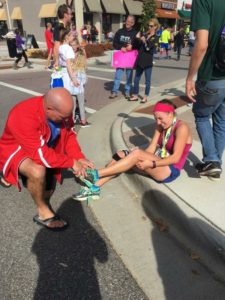Seeing how this past week was #Globalrunningday I wanted to reflect and analyze 10 things I learned from running my first marathon a year and a half ago.

1) Self-awareness is key
Know your identity, values, and what works for you. If you know how to identify yourself, what values you want to live by, and what your limits are you will be more successful and driven in whatever you choose to do. Know your purpose and your reasoning for doing it.
I have never identified myself as a distance runner, I’ve always been a sprinter in track and field. Running a marathon was never even on my bucket list. Why would I EVER want to put myself through that excruciating pain of training and running for 26.2 miles? It never seemed exciting and I was lucky if I could run over 30 minutes.
I do identify myself though as a competitive person and a challenge-seeker. I value hard-work and trying things out of my comfort zone. This is what led to my decision to run a marathon. When my good friend in graduate school Sofia expressed her interest in running a marathon I responded, “Good for you, I will definitely cheer you on!” Her response was, “No you’re running with me.” I laughed and when I saw her still looking at me with a straight face I knew she was serious. That was it and I was up for the challenge.
2) Establishing a support team is crucial
Not going to lie, the training was time-consuming, painful, and exhausting. We decided to follow the Chicago Marathon training guide, which included hills, speed work, and track intervals. This was much more ideal for me with my track and field background compared to the other training regimens that only had different miles to run each day. I knew that would bore me to death and I needed more variety. (Again referring to point one, KNOW WHAT WORKS FOR YOU!)
After a few months in I was starting to feel pretty confident in my abilities. I surprised myself with how fast I increased my cardio and was able to run for longer chunks of time without stopping. It definitely helped to have Sofia there because if she didn’t stop running I was definitely not going to be the one to back down. We pushed each other in every run, encouraged each other through the pain, and since we were roommates we could get each other out of bed for those early 5 am runs. She even pushed me when I wanted to back out of a challenging hill workout in 100-degree weather and we couldn’t walk for the next two days due to our calves being as stiff as rocks. Without her support and encouragement, the training runs and the race itself would not have been as fun.
3) Trust your training
I remember vividly our 18-mile run. This was our longest run so far and afterward, we had one more long run left before the marathon. I felt great! It was surreal to be able to run that long, on pace, and finish the last two miles even faster with a kick. This marathon that I was formerly dreading definitely felt manageable and I was excited to hit my goal of running under 4 hours.
Then came the injury.
I had about a month before the marathon and could barely run without pain. In order to overcome these doubts, I had to remind myself of the previous training I had done. I built a strong base that would allow me to finish the race, even with the lack of training in the last month. I would review my former workouts as reminders of what I had already done and how far I had come. I had to trust that my cross-training pool workouts would be enough and that I did not lose the fitness and strength that I had already built.
4) Pay attention to what your body needs
After the 18-mile run, I should have been more aware of my Fitbit tracker results. My resting heart rate skyrocketed and I was not recovering the proper way. The next few weeks I could hardly walk without pain throbbing in my outer knee from my IT band. I tried to push through the workouts but always had to finish early. I decided to take a few weeks off and focus on recovering workouts such as pool running, swimming, biking, and yoga. My IT band just wouldn’t release.
This lasted for about a month and I barely could get any running workouts in. My roommate Sofia finished training the last month by herself. I have never been so worried and anxious for a race before. I would have nightmares of quitting the marathon or I imagined myself having to walk the entire race, which would leave my roommate to run by herself and my marathon would turn into 8 hours instead of 4.
I researched everything I could for my IT band. I was trying out different stretches, foam rolled constantly, completed strengthening exercises for the muscles around my IT band, and carried a lacrosse ball to roll onto the tight spots. I even had two full-body massages, several chiropractor appointments, took Epsom salt soak baths, went to doctors, and had Graston treatment done.
It is important to pay attention to your body. Make sure you recover properly and listen to what it is telling you. Get your sleep, eat correctly, watch your heart rate, and take a day off of training if that is what you need. If I did this early in my training I may have been able to recover better after my 18-miler and possibly prevent or reduce the IT band injury.
5) You can overcome things that others may not think you can
It was two days before the marathon and at this point, I had several people telling me to drop out. I was frustrated by their comments because I felt like this was not an option. I had been training all summer for this, put my body through hell, and I needed to finish what I started. I am not a quitter. Thankfully, my roommate supported me in whatever decision I wanted, which is what I needed tremendously.
I could have easily listened to those who told me to drop out, and I did consider it. Sometimes it is better to listen to others but keep in mind that no one will know yourself and what your limits are better than you. They give advice because they care, but you make the ultimate decision.
6) Preparation breeds confidence
I attempted a slow 2 mile run two nights before the race to see how my IT band was feeling since I hadn’t been running in almost a month. I got .75 miles in and I had to stop because I was nearly in tears from the pain. I walked back home with my head down and my hopes sinking.
The next night I bought Kinesio tape and a knee brace to prevent the oncoming throbbing pain that I knew I would inevitably endure in this race. I anticipated that this marathon will probably be the most painful experience of my life and I wanted to be as prepared as possible.
During the injury, I lacked confidence in my ability to run. What helped was reminding myself of all of the training I already did. I visualized and re-experienced my previous successful runs to remind myself that I am capable and prepared for this run, regardless of the injury. I also became more prepared by investing in a knee brace, Kinesio tape, and all of the treatments/recovery exercises I had done on my IT band. The more you prepare, the more confident you will feel.
7) Goal-setting is important, but remember to modify as needed
My former goal for the marathon was under 4 hours, which is what I was on pace to run before my injury, but I modified it after my injury to just finishing the race. I had certain my previous goals established but was willing to modify my goal of running under 4 hours after the injury. These goals assisted me in adhering to my training regimen and provided motivation during my race.
When race day arrived I had the support of my roommate, boyfriend, parents, stepparents, and siblings. With them on my side, I was confident and determined to finish somehow. As the race started my roommate and I followed behind the 4-hour pacer. I began at a slow and comfortable pace and started to fall behind. I wanted to ease off because I worried that getting out too hard would onset the IT band pain and once it flared up it wouldn’t go away. My goal was to prevent the pain as long as possible otherwise it would be harder to run the marathon if it started early on. We fell pretty far behind the 4 miler pacer and my roommate began to worry we were too off pace. I encouraged her to go ahead and that I would try to catch up if I can once I eased my nerves and felt warmed up.
8) Talk to yourself, don’t listen
A few miles in I was running by myself and alone with my thoughts. It was definitely a lonely couple of miles. My thoughts told me to slow down, throw in the towel, and focused on the anticipation of the pain occurring at any moment. After passing my family a couple of times it hit me. “What are you doing Jenna?” I asked myself while running alone. I finally confronted my worries, concerns, frustration, and anticipation. It was time to have a serious conversation with myself.
“You did NOT sign up for this marathon to run it by yourself. You and Sofia made a pact to run this together. Without her, you wouldn’t even have considered running this race. You are HOLDING BACK because you fear something that might happen regardless of your pace. Pick it up and get back to the pace you told yourself you were going to run and find Sofia.”
This is what I needed. I needed to give myself a good kick in the butt for holding myself back from meeting my goals. I was running scared and timid, which is not the kind of competitor that I am. I decided that I didn’t care if my IT band acted up or not. I would rather run this race with my friend by my side just like we ran all of our training runs than to run a dreadful 26.2 miles all by myself. This wasn’t the plan. So I stopped listening to my thoughts and talked to myself instead and started to pick it up.
9) Being alone is not fun or helpful
It took me about a mile or two to catch up, but eventually, I did. I was moving at a comfortable, but strong pace with my friend by my side. We matched strides and proudly maintained our pace right behind the 4-hour pacer. This made the race so much more bearable. My thoughts were no longer on waiting for my knee to lock up with throbbing pain and how much this race sucked by myself. Instead, I was enjoying running with a pack of people with all different stories and backgrounds. The miles flew by while indulging in conversations with one another and being cheered every mile or so by my amazing fan club.
In those earlier miles, when I ran by myself, I lacked the support and camaraderie that I would have had running with a group. Realizing how lonely and hard it would be run the run solo motivated me to kick it in and fight to run with the 4-hour pack. It made a world of difference once I had the support of a group to run with.
10) Your mind is more powerful than you think
Within the last five miles, I was in the zone. I pressed on and felt like I could kick in another gear. I told Sofia I was taking off and she came with me. There were miles of pain up ahead but we pursued. We used each other, our mantras, and our supporting fan club to focus on our goals. One step at a time. I used every mental training trick I could think of. I sang, “Left, left, left right left” in my head for hours, repeated the mantras that I wrote on my arm as reminders, and towards the end became mindful. In the last few painful miles, I focused on whatever color shirt the person ahead of me was wearing. Every time I focused on a color I unconsciously met their strides and would gradually speed up and pass them. Yellow, Red, Black, White, Blue. I passed them all. I refused to focus on the pain my body was feeling and only focused on the color ahead. I felt invincible. I felt strong. I felt determined.
I saw the finish line up ahead and started to kick it in, at least that was the plan, I really doubt I was moving much faster. I propelled my arms as fast and strong as I could across the finish line. We finished, we were done! My final time was 3:49, which surpassed our goal of 4 hours. The timing was just the cherry on top. Most importantly, I was gleaming because I finished despite my IT band injury. I realized that your body won’t quit if your mind is still in the game.
——
To this day I have no idea how I finished that race. I’m not sure why my IT band didn’t act up when two days before I couldn’t manage running a single mile. Maybe it was the Kinesio tape, maybe it was the knee brace, or maybe it was because I changed my mindset to focus on the present moment instead of anticipating the pain to present itself. All that mattered to me was that I finished. Take that Doctors who encouraged me to quit! (Not really though, I knew they were only doing their job and looking out for my health and well-being.)
I did have some painful toes though at the end. Luckily I had my supportive father there to assist in taking off my shoes. 🙂

—–
To wrap up here are the 10 lessons:
1) Self-awareness is key
2) Establishing a support team is crucial
3) Trust your training, even when your training isn’t where you want it to be
4) Pay attention to what your body needs
5) You can overcome things that others may not think you can
6) Preparation breeds confidence
7) Goal-setting is important, but remember to modify as needed
8) Talk to yourself, don’t listen
9) Being alone is not fun or helpful
10) Your mind is more powerful than you think
——
Share your thoughts on the post, I’d love to hear from you! Apply these 10 principles and learning lessons to your game, race, or event to keep that eye of the storm mentality!













